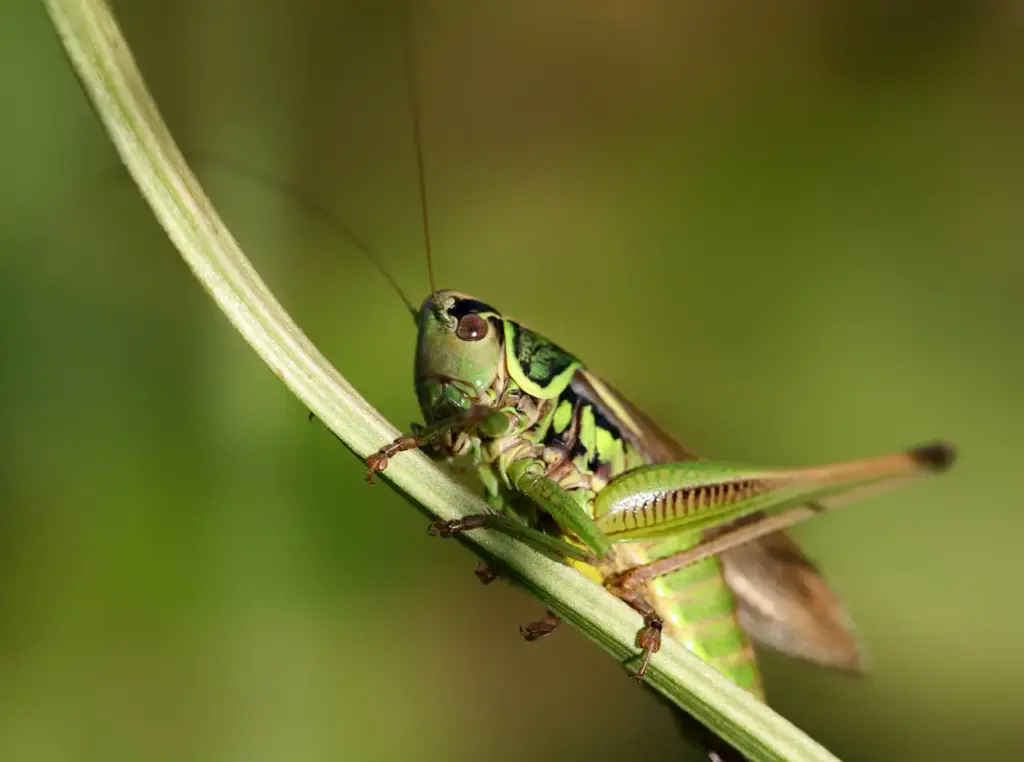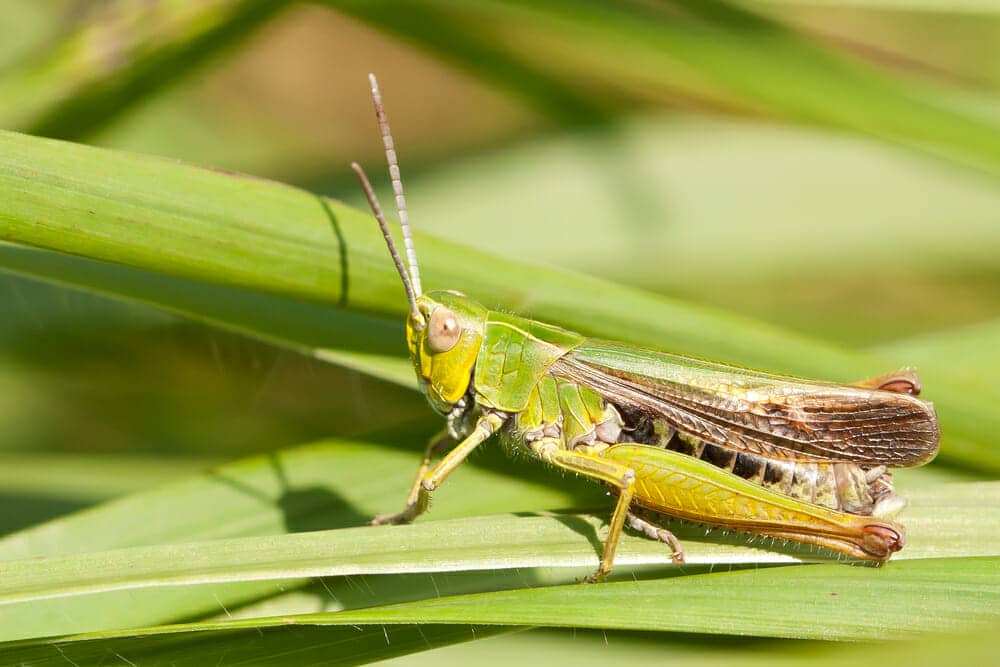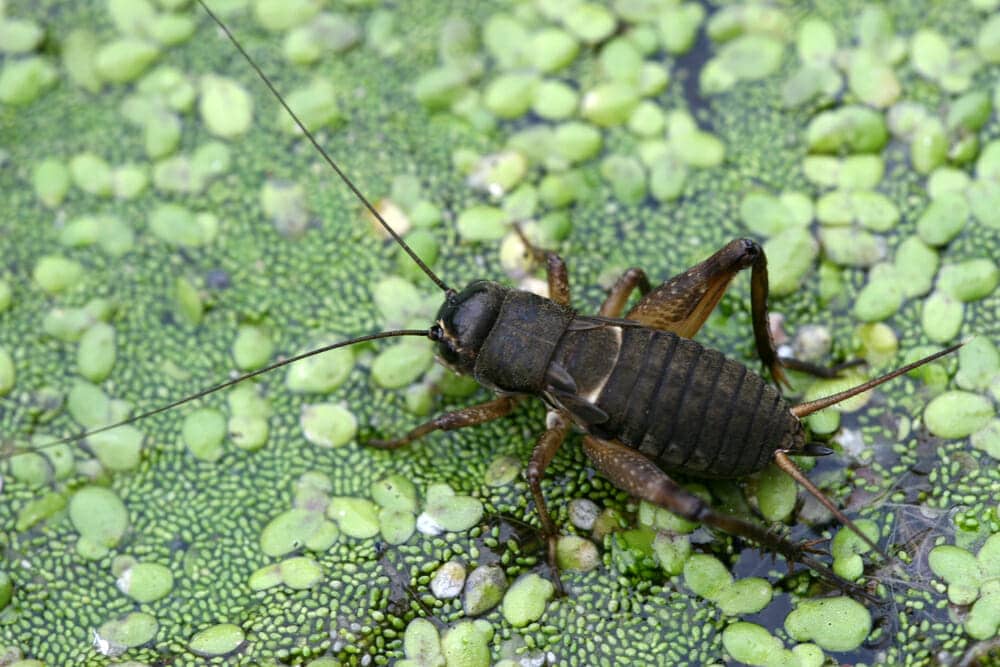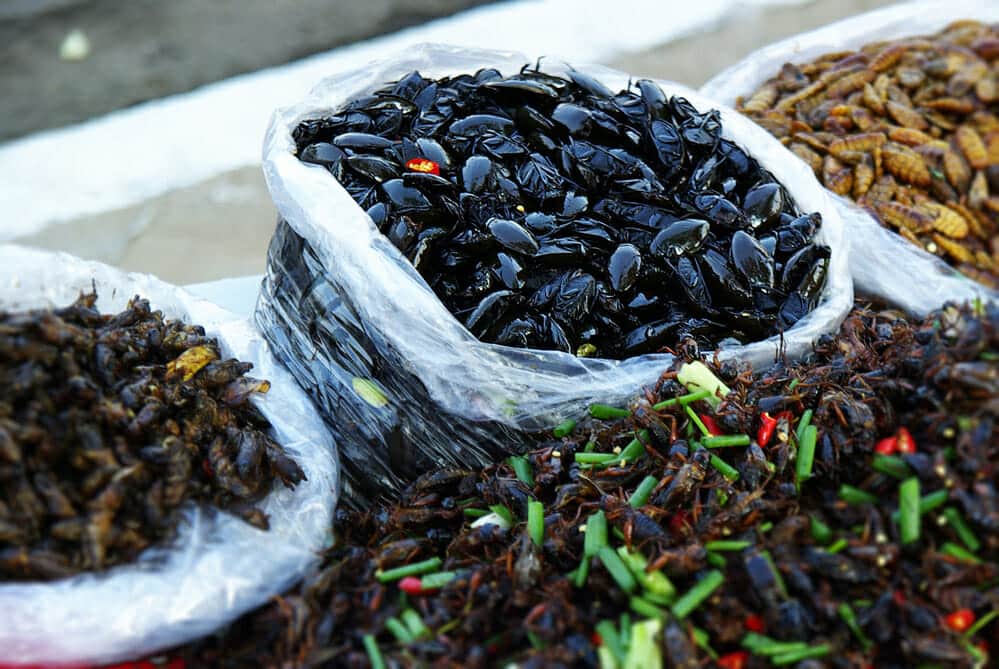Orthoptera Order
Orthoptera Order, Classification, Taxonomy, Habitat & Life Cycle
The Orthoptera is an order of large and easily recognized insects, which includes the Grasshoppers, Locusts, Groundhoppers, Crickets, Bush-crickets (called Katydids in America), Mole-crickets and Camel-crickets as well as some lesser groups.
There are about 25,000 known species of Orthoptera distributed around the world. Some species are widespread, and a couple occurs in both the old and new worlds.

Classification, Taxonomy & Distribution
The order is subdivided into two suborders:
Caelifera
This group comprises various crickets. They have antennae that at least reach their abdomens and usually reach beyond them.
The Mole-crickets have the shortest antennae in this group, though they are still longer than the Grasshoppers. Also, Crickets differ in that they have their ears on their fore tibia (front legs).
Ensifera
This group comprises Grasshoppers, Locusts, and Groundhoppers. All have short antennae, and their ears (tympanal organs) are on either side of the first segment of their abdomen.
Did you Know?
The smallest Grasshopper in the world is the South African Lithidium pusillium, and the largest is the South American Tropidacris latreillei.
Among the more unusual Orthoptera is the Proscopiidae of South America, which are extremely thin and elongate, resembling Stick-insects more than their Orthopteran allies.
The Stenopelmatidae is a family of about 200, primarily nocturnal, species, many of which live in rotting wood or leaf litter. They include the Australian King Crickets (Australostoma sp.) and the New Zealand Giant Wetas (Deinacrida sp.).
Distinguishing taxonomic features
Orthoptera is described as hemimetabolous (having nymphs that look like small adults and no pupa).
Medium or large insects are usually winged as adults but may be apterous (wingless).
They have a large pronotum (the plate covering the first thoracic segment or prothorax; see insect thorax) and enlarged (often greatly so) hind femur, which are used for jumping.
In the winged forms, the fore wings are toughened and strengthened to form tegmina; the hind wings are membraneous and folded fan-like.
They usually have large, well-developed compound eyes as well as three ocelli. Their cerci are generally short and segmented, and their mouthparts are designed for biting.
Females usually have a well-developed ovipositor, which is more evident in the Crickets and Bush-crickets.
Their antennae are long and filiform in the Ensifera, consisting of a large number of segments, but short consisting of less than 30 segments in the Caelifera. It is considered by most scientists that the Orthoptera arose in the late Upper Carboniferous more than 300 million years ago.
Orthoptera Taxonomy
- Insect Order: Orthoptera
- Suborder = Ensifera
- Superfamily = Gryllacrdoidea
- Family = Stenopelmatidae
- Family = Gryllacrididae
- Family = Schizodactylidae
- Family = Rhaphidophoridae
- Superfamily = Tettigonioidea
- Family = Haglidae
- Family = Tettigoniidae
- Superfamily = Grylloidea
- Family = Gryllidae
- Family = Gryllotalpidae
- Superfamily = Gryllacrdoidea
- Suborder = Caelifera
- Superfamily =Acridoidea
- Family = Eumastacidae
- Family = Pneumoridae
- Family = Pamphagidae
- Family = Pyrgomorphidae
- Family = Acrididae
- Family = Proscopiidae
- Family = Tetrigidae
- Superfamily = Tridactyloidea
- Family = Tridactylidae
- Family = Cylindrachetidae
- Superfamily =Acridoidea
- Suborder = Ensifera
Orthoptera Ecology
Habitat
The Orthoptera can be found in most habitats.
As well as the more familiar species found in Grassland and Forest, the Scaley Cricket (Pseudomogoplistes squamiger) can be found on Sea-shores.
The Large Marsh Grasshopper (Stethophyma grossum) and Bog Bush-cricket (Merioptera brachyptera) can be found in Bogs and Marshes, and the Camel Crickets are naturally caving dwellers.
The Desert Locust Schistocerca gregaria lives in the Desert and Semi-Desert, while the Mole-cricket (Gryllotalpa gryllotalpa) lives underground.
Interesting Fact
Many species are arboreal (live in trees), i.e., the Oak Bush-cricket (Meconoma thalassinum), and some are pretty happy swimming on or even under the water, i.e., the Slender Groundhopper (Tetrix subulatum).
Though some species are very cosmopolitan, i.e., the Meadow Grasshopper Chorthippus parallelus and the Great Green Bush-cricket Tettigonia viridissima, others can be pretty specific in the habitat requirements, i.e., Turks Groundhopper Tetrix tuerki which lives only on alpine stream gravel banks.
Feeding
Though most of the Orthoptera eat vegetable matter of some sort only, Grasshoppers, Groundhoppers, and a few rare Bush-crickets are predominantly herbivorous (eat only plant material).
Most of the rest are omnivorous (eating plants and animals), eating whatever comes their way.
Some, however, like the Oak Bush-cricket (Meconoma thalassinum), the White Faced Decticus (Decticus albifrons), the Green Grasshopper (Tettigonia virridissima), and the Mole-cricket (Gryllotalpa gryllotalpa) are primarily carnivores and active predators, though some of them will take some of the more succulent plant material as well.
Orthoptera Lifecycle
Egg laying
Orthoptera eggs are laid in a variety of places.
With their large sickle-shaped ovipositors, the Bush-crickets either lay their eggs in the soil or insert them into various plant materials.
The rest of the Crickets lay their eggs in the soil, and the Caelifera all lay their eggs singly or in small groups.
Among the Ensifera, the Groundhoppers lay their eggs in small groups or bundles clumped together with a stalk. The Large Gold Grasshopper lays its eggs in a frothy sort of case (like polystyrene) in the broken stems off stems of woody plants.
Most of the remaining Ensifera lay their eggs in a frothy sort of case (like polystyrene) in the soil, the eggs are laid near the bottom, and the hatchlings climb up out through the frothy tube.
The eggs are generally over winter, except in Crickets and Groundhoppers, which go over winter as nymphs or adults, particularly the Mole-cricket, which has a two-year life cycle.
Did you Know?
In the Great Green Bush Cricket (Tettigonia viridissima), the eggs can remain dormant for at least one, if not two, seasons, taking 2 or 3 years to hatch.
Growth and life span
The Orthoptera nymphs first hatch out in a sort of safety suit that wraps all their limbs close to their body (at this stage, they are called a ‘pronymph’).
They then work their way slowly to the surface, pushing through the soil or foam above them with the help of an expanding sack in the top base of their necks (the cervical membrane), which forces aside a little bit of the intervening substance each time an influx of blood expands it.
Several nymphs may work together with the Grasshoppers and Locusts to force the hardened top off the foam egg case.
When they reach the surface, they escape from their safety suit and search for food. At first, they are a pale white color, but within a few hours, they have gained their normal color.
Grasshoppers have 4 or 5 instars, Bush-crickets 5 to 7, and Crickets as many as ten and up to 15 sometimes.
The nymphs have small wing pads, which gradually get larger at each molt. They are unusual in that the hind wing pads are broad and folded back over the forewings.
The females also have the ovipositor develop slowly, getting larger at each molt. Most species are Univoltine (having one generation a year), the exception being the Mole-cricket (Gryllotalpa gryllotalpa) which has, as mentioned above, a semivolatile, two-year life cycle.
Mating
In the Ensifera, mating is pretty straightforward. The male approaches the female, and if she is ready to mate, the male mounts her, and mating takes place.
It can last from 20 minutes to several hours, and the male may fall off the female and be dragged around on his back by her.
In most of the Caelifera, mating is also fairly straightforward but may be preceded by the couple standing face to face caressing each other with their antennae.
The Bush-crickets are more unusual, the male often hangs off the female in various positions and may end up upside down hanging off her ovipositor.
The male then produces a large gelatinous spermatophore, which he attaches to the female’s genital opening.
This may have several segments and look like a sort of milky fruit. As soon as this process is complete, the male escapes before the female eats him (while he is vulnerable in his exhausted state).
The female then proceeds to eat the spermatophore from the outside while the sperm enters her genital opening, this usually takes several hours.
Physiology and biochemistry
Sound and hearing
The Orthoptera are renowned for their songs, and in some Eastern countries, males (females generally do not sing) are kept in small cages, specifically so that the keepers can enjoy their songs.
Most species, particularly crickets, use three different sorts of songs:
- Calling songs: species-specific to “call” females from far away.
- Courtship songs: are mainly only used if males and females have antennal contact.
- Aggressive songs: “battle” calls, male to male, one male telling all the other males to stay away.
They produce their songs in a variety of different ways. Most of the Caelifera rub one forewing (tegmina) against the other.
The right wing is always on top in the Field Cricket (Gryllus campestris) and other Crickets. Whereas Bush crickets always have the left wing on the top.
If you are curious about how they sound, have a look below!
A ridge makes the sound of teeth, ‘a bow’ on the underside of the upper wing being dragged across a ‘scraper’ (a strengthened vein) on the top side of the lower wing. The sound is then amplified by the ‘harp’ and the ‘mirror’ areas of the stretched membrane in the wings (the Bush-crickets only possess the mirror).
Interesting Facts
In 1992 a fellow named R.B. Toms found that, in some Crickets, the chirp frequency is directly related to the temperature.
You can tell the temperature by counting the number of chirps and knowing the singing species. I.e., for Oecanthus karschi: temperature in degrees C = the number of chirps in 6 seconds + 12.
Grasshoppers rub one or both hind femora over their tegmina, there is a special toothed area on the inside of the femora, which causes the tegmina to vibrate. In Locusts there are no teeth on the inside of the femora. Instead, they have a specially raised ‘intercalary vein’ on the tegmina with teeth.
In many species of Grasshoppers, the female sings a softer, quieter song to indicate that she is ready to mate.
Camouflage
Grasshoppers and crickets are camouflage artists who can blend in with their surroundings. They have a color-changing ability that matches the color and texture of leaves, branches, and even soil.
The color of many grasshoppers changes over time. With each subsequent molt, the color of many species’ nymphs changes, possibly in response to shifts in their preference for particular microhabitats. As their food sources change, other species also change their color.
Crickets also use their camouflage abilities to hide from predators. They often have a mottled brown color, allowing them to blend in with leaves and twigs on the ground.
However, unlike grasshoppers, crickets cannot change color on the spot. These little creatures need to molt to change their color.
Defense
Grasshoppers use their mouths to expel digestive fluids as a defensive measure when threatened. The brown liquid substance that grasshoppers release may resemble tobacco spit.
This substance is a mixture of saliva and other gastrointestinal enzymes. It is acidic, smelly, unpleasant to taste, and can stain. It is a potent combination that deters predators from using this insect as food.

A grasshopper’s hind legs also aid in defense, as they can jump long distances to escape danger. They may use this to kick and ward off predators when fighting smaller prey.
Unfortunately, crickets don’t actively defend themselves. Instead, they have long hairs called cerci on the end of their abdomen. This detects vibrations and movements in the air and on the ground, warning them of potential predators.
Once they notice a threat is near, they can quickly escape by jumping away.
Body composition
Regarding insect anatomy and body composition, grasshoppers have a relatively straightforward structure. They have three body parts (head, thorax, and abdomen), two antennae, and six legs on their thorax. These legs are strong and allow them to jump great distances.
Some grasshoppers also have wings, allowing them to fly, while others may be wingless. An excellent example of a wingless grasshopper is the long-horned grasshopper, which instead relies on its strong jumping abilities to escape predators and locate food.
The cricket has three body parts, two antennae, and six legs on its thorax. However, their hind legs are greatly enlarged and act as powerful springs for jumping. They also have wings.
Crickets, on the other hand, have elongated bodies and long antennae. They also have strong back legs that allow them to jump long distances, making them excellent at escaping predators.
Crickets also have wings, but they prefer to jump rather than fly.
Their wings are also used for singing, as they rub them against each other to create their distinctive chirping noise. This sound is used primarily by male crickets to attract mates and establish their territory within a group of crickets.
Hormones
While grasshoppers and crickets undergo molting to grow and develop, they also release hormones to regulate the molting process. In grasshoppers, a hormone we call Eddystone triggers the molting process and helps them shed their old exoskeleton and grow a new one.
Crickets also produce this hormone, and another one is called juvenile hormone, which helps regulate the molting process and determine whether they will grow into adults or remain in their juvenile form.

Both grasshoppers and crickets also release mating hormones to attract mates and reproduce.
The insect life cycle often starts with mating and egg-laying, followed by an immature stage before adulthood.
In grasshoppers, females release pheromones through their hind legs to attract males and signal their readiness to mate. Insect reproduction
In crickets, males release pheromones through their wings and antennae to attract females.
Relationships with humans
No matter how small or big, every creature in this world plays a role in the ecosystem. The same goes for grasshoppers and crickets, which play a vital role as predators and prey in the food chain.
Also, pet cricket can make an excellent addition to your household.
These insects also have a crucial role in human agriculture, as they can act both as crop pests and as natural pest control. In small numbers, they eat crop-damaging insects, helping to control pest populations naturally.
However, in large numbers, they may also feed on crops and cause damage to agricultural yields.
Four grasshopper species cause nearly all crop damage: the differential, migratory, red-legged, and two-striped. Farmers often use pesticides and natural means, such as introducing natural predators or planting trap crops, to control grasshopper populations.
Similarly, certain cricket species can also damage crops in large numbers. The greenhouse camel cricket is a pest in greenhouses and can damage plants and stored products. Pest control measures are used to keep their populations in check.
Grasshoppers and crickets tend to feed on crops such as corn and soybeans. However, in a way, they also protect these crops by providing on insect pests that may harm them.
Pests that they may eat include aphids, beetles, and caterpillars. These insects are known for their destructive feeding habits, causing damage to crops and reducing their yields.
By controlling pest populations, grasshoppers and crickets indirectly help maintain crop health and productivity.
In addition, grasshoppers and crickets are also commonly eaten by humans in many parts of the world. They are a source of protein and can be cooked in various ways, such as frying or roasting.

Thailand, Mexico, and several African countries are known for their dishes featuring grasshoppers and crickets.
Biofuel production is also an emerging use for grasshoppers and crickets. As they are high in protein and fatty acids, they can be used to produce biodiesel fuel as an alternative energy source.
Biofuel is also being researched as a more sustainable and environmentally-friendly option for energy production.
Many countries are currently studying and experimenting using grasshoppers and crickets for biofuel production. The help of these tiny insects may be the key to finding a more sustainable energy source for the future.
Grasshoppers and crickets play essential roles in the ecosystem and human society. These small insects significantly impact our world, whether it’s as natural pest control, a source of food, or a potential biofuel source.
FAQs
Why is it called Orthoptera?
What is the common name for Orthoptera?
How does Orthoptera reproduce?
What Next?
I hope this introduction to the musical world of grasshoppers and crickets has been exciting!
Gordon is an ecologist with two degrees from Exeter University. He’s also a teacher, a poet and the owner of 1,152 books. Oh – and he wrote this website.
Disclaimer
Earthlife.net does not provide medical advice. We do our best to help users understand the science behind living beings; however, the content in the articles and on the website is not intended to substitute for consultation with a qualified expert. By interacting with the website and/or our email service, you agree to our disclaimer. Remember that you must consult a specialist before using any of the products or advice on the web.
